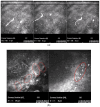Concomitant Potentially Contagious Factors Detected in Poland and Regarding Acanthamoeba Strains, Etiological Agents of Keratitis in Humans
- PMID: 39770648
- PMCID: PMC11676076
- DOI: 10.3390/microorganisms12122445
Concomitant Potentially Contagious Factors Detected in Poland and Regarding Acanthamoeba Strains, Etiological Agents of Keratitis in Humans
Abstract
Background: Diseases in humans caused by amphizoic amoebae that can result in visual impairment and even blindness, have recently been identified more frequently worldwide. Etiologically complex incidents of keratitis, including those connected with Acanthamoeba strains detected in Poland, were evaluated in this study.
Methods: Corneal samples from cases resistant to antimicrobial therapy assessed for epidemiological, microbiological and parasitological aspects were investigated by phase-contrast microscope, slit lamp and by confocal microscopy. In vitro techniques were applied for detection of bacteria and fungi, and corneal isolates cultured under axenic condition using BSC medium-for detection of Acanthamoeba spp.; molecular techniques were applied for amoeba species identification.
Results: Most etiologically complicated keratitis cases, detected in ~84% of incidents, was due to exposure of contact lenses to tap water or pool water; trophozoites and cysts of Acanthamoeba, concomitant bacteriae, e.g., Pseudomonas aeruginosa, fungi and microfilariae were identified in contact lens users.
Conclusions: In samples from contact lens wearers where microbial keratitis is identified along with some connection with the patient's exposure to contaminated water environments, a risk of Acanthamoeba spp. infections should be considered. Understanding the complicated relationship between Acanthamoeba spp., co-occurring pathogens including associated endosymbionts is needed. In vivo confocal microscopy and in vitro cultivation were necessary to identify potentially contagious concomitant factors affecting the complex course of the keratitis.
Keywords: Acanthamoeba keratitis; cellular and molecular diagnostics; co-occurring infections; concomitant factors; confocal microscopy; corneal isolates; in vitro methods; infectious strains; microbiota; non-invasive in vivo methods.
Conflict of interest statement
The authors declare no conflicts of interest.
Figures






Similar articles
-
Assessment of in vitro dynamics of pathogenic Acanthamoeba strains originating from contact lens wearers with infectious keratitis.Ann Parasitol. 2016;62(4):331-336. doi: 10.17420/ap6204.69. Ann Parasitol. 2016. PMID: 28170206
-
In vivo confocal microscopy and in vitro culture techniques as tools for evaluation of severe Acanthamoeba keratitis incidents.Ann Parasitol. 2017;63(4):341-346. doi: 10.17420/ap6304.121. Ann Parasitol. 2017. PMID: 29420872
-
Successive Acanthamoeba Corneal Isolates Identified in Poland Monitored in Terms of In Vitro Dynamics.Microorganisms. 2023 Apr 29;11(5):1174. doi: 10.3390/microorganisms11051174. Microorganisms. 2023. PMID: 37317148 Free PMC article.
-
Strategies for the prevention of contact lens-related Acanthamoeba keratitis: a review.Ophthalmic Physiol Opt. 2016 Mar;36(2):77-92. doi: 10.1111/opo.12271. Epub 2015 Dec 21. Ophthalmic Physiol Opt. 2016. PMID: 26691018 Review.
-
Infectious keratitis: A review.Clin Exp Ophthalmol. 2022 Jul;50(5):543-562. doi: 10.1111/ceo.14113. Epub 2022 Jun 3. Clin Exp Ophthalmol. 2022. PMID: 35610943 Free PMC article. Review.
References
LinkOut - more resources
Full Text Sources
Miscellaneous

